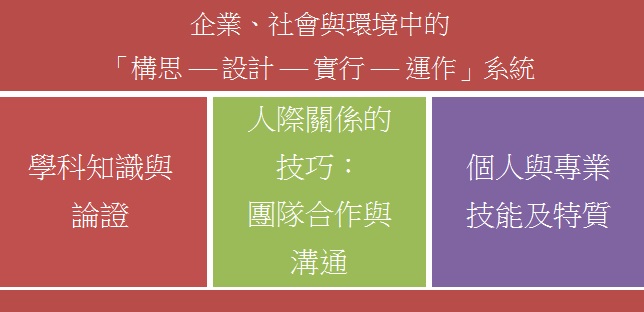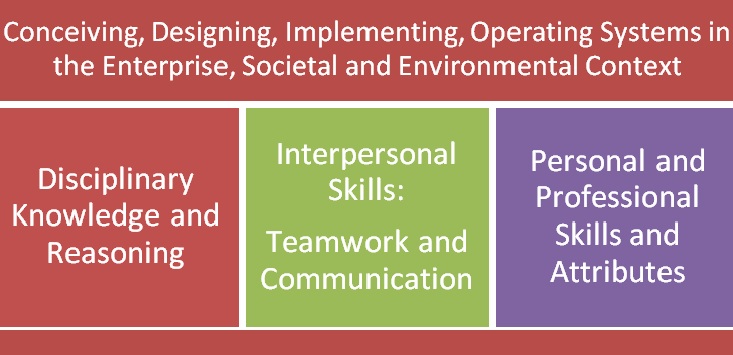教學資源: 跨學科學習:善用「 構思-設計-實行-運作」(CDIO) 的架構
CDIO是什麼?
CDIO 是「構思 (Conceive) ⎯設計 (Design) ⎯實行 (Implement) ⎯運作 (Operate)」的簡稱, 這概念為全球大學及學院的課程規劃及目標為本評核提供了學與教架構。CDIO的概念於1990年由美國麻省理工學院創立,及至2000年後進一步成為新發展項目。目前CDIO組織已與全球七個地區,包括:歐洲、北美、亞洲、非洲、愛爾蘭、拉丁美洲及澳洲和紐西蘭,超過一百二十所大學和學院,如列斯大學(University of Leeds)、萊斯特大學(University of Leicester)和史丹福大學 (Stanford University) 等,成為合作伙伴,共同發展CDIO項目。
CDIO 的概念,原意為改革教育而提供嶄新的架構,為二十一世紀培育切合行業需要的世界級工程師。現在,無論研究型大學或本地學院,都廣泛應用這架構提倡跨學科學習 (CDIO組織,2010)。本文將探討其主要重點,並從課程設計與實行的角度,分析這架構為學與教所帶來的啟示。
 (圖像由 CDIO 組織提供,2016)
(圖像由 CDIO 組織提供,2016)
CDIO發展項目
CDIO發展項目著重課室、實驗室和工場中的主動和協作性學習,尤其重視團隊合作和溝通技巧 (Singapore Polytechnic, 2013)。 CDIO 發展項目的重點之一為其課程大綱,這大綱可分成四部分:(1) 學科知識與論證;(2) 企業、社會與環境中的「構思 ⎯ 設計 ⎯ 實行 ⎯ 運作」系統;(3) 人際關係的技巧:團隊合作與溝通;及(4) 個人與專業技能及特質。其理念在於採用計劃項目為本的學習模式,綜合各學科知識以建立一個新的課程(CDIO組織,2010)。
 CDIO的課程大綱
(圖像由教學中心提供,2016)
CDIO的課程大綱
(圖像由教學中心提供,2016)
麻省理工學院早期的成功
在芸芸的合作伙伴中,麻省理工學院早以成功地應用CDIO而聞名。其航空工程課程經修改後,加入設計和建設的計劃項目,令學生得到機會發揮創意,解決實際生活的問題,因而變得積極投入學習,更裝備他們擁有CDIO的技能來設計、建立和操作產品系統 (Gustafsson, Malmqvist, Newman, Stafström, & Wallin, 2009)。除了解決問題外,不同課程亦安排了由淺入深的合作計劃項目,使學生可以在一個全面的計劃項目中,結合並應用跨學科的知識(MIT, 2006)。
CDIO提升學與教的效能
CDIO的架構提供了課程發展的工具,檢討和組織各單元與課程,培育出對工作、生活及世界層面皆準備就緒的畢業生 (Singapore Polytechnic, 2013)。CDIO標誌著四個重要的階段,孕育學生具備分析能力、創意思維和溝通技能 (CDIO組織,2010)。
 |
構思
界定顧客的需要,考慮科技的運用和行業條例,並發展相關的概念、技術和商業計劃。 |
 |
設計
為產品進行設計、計劃或繪圖。 |
 |
實行
透過製作、測試和驗證,將概念變成產品。 |
 |
運作
利用製成品為他人帶來價值,包括保養、發展及停止有關系統。 |
CDIO架構提供綜合課程,提倡全面的教育。大家只需利用相同的工具或證據,就可進行產品或系統的綜合評估,節省了師生評估相關學習成果的時間(New Zealand Qualifications Framework, 2011)。
CDIO架構同時提倡跨學科學習。例如瑞典的林雪坪大學(Linköping University)就為文學院、理學院、科技研究院和健康科學學院即將畢業的學生提供跨學科的合作計劃項目,讓他們為指定公司開發新的概念或樣品。透過不同專家於同一計劃項目下的努力,跨學科的團隊人員不但從中學到個人與專業的技能及特質,還有機會建立不同的關係網,因而可能得到未來僱主的垂青(CDIO組織,2010)。
綜合以上各個優點,現在我們該是時候考慮將來課程設計時,結合CDIO架構的可能性。由於這大規模的轉變涉及不同學科的合作,首要任務是要探索其可行性,如鼓勵同事到合作伙伴的院校作學術探訪和參加研討會或工作坊,分享意見及實踐體驗。下一個挑戰將會是拓展行業伙伴的網絡,給學生製造機會,為實際工作環境的問題設計具創意的解決方法。憑著共同的努力和願景,讓我們一起見證準備就緒的畢業生,在二十一世紀面向世界,展開璀璨的前程。
如欲知道更多成功的故事,請瀏覽:www.cdio.org。
CDIO知識庫
CDIO知識庫提供大量與2000年至2015年CDIO研討會有關的書籍記載、演講資料、計劃項目、技術報告及工作文件等。如想獲得更多經驗及資料,請瀏覽:http://www.cdio.org/knowledge-library。
參考文獻:
CDIO Organisation. (2010). CDIO Initiatives and Knowledge Library.
Retrieved May 25, 2016, from
http://www.cdio.org/
Gustafsson, G., Malmqvist, J., Newman, D.J., Stafström, S. & Wallin, H.P. (2009).
Towards a New Model for First-Year Introductory Courses in Engineering Education Programmes.
Retrieved May 27, 2016, from
http://www.cdio.org/implementing-cdio-your-institution/startup-advice/early-successes
MIT. (Massachusetts Institute of Technology). (2006). CDIO.
Retrieved May 25, 2016, from
http://web.mit.edu/edtech/casestudies/cdio.html
New Zealand Qualifications Authority. (2011). Assessment Tools and Approaches.
Retrieved June 1, 2016, from
http://www.nzqa.govt.nz/providers-partners/
assessment-and-moderation/assessment-of-standards/
generic-resources/assessment-tools-and-approaches/
Singapore Polytechnic. (2013). Teaching and Learning.
Retrieved May 24, 2016, from
http://www.sp.edu.sg/wps/portal/vp-spws/!ut/p/c1/
04_SB8K8xLLM9MSSzPy8xBz9CP0os_hQD1NXIzdTEwOLMEs3A09_xwB_F7cwRxNjA_2CbEdFABoCxrw!/
?WCM_GLOBAL_CONTEXT=
Resources: Cross Disciplinary Learning with CDIO
What is CDIO?
CDIO stands for Conceive (C) - Design (D) - Implement (I) and Operate (O). It is a learning and teaching framework for curricular planning and outcome-based assessment of worldwide university and college programmes. This concept was incepted by Massachusetts Institute of Technology (MIT) in 1990 and further developed into CDIO Initiative in 2000s. CDIO has gained the collaboration with over 120 universities and colleges organised in 7 regions: Europe, North America, Asia, Africa, Ireland, Latin America, and Australia and New Zealand. Amongst them, the University of Leeds, the University of Leicester and the Stanford University are some of the collaborators.
CDIO was originally formulated to provide an innovative framework for reforming education to produce world-ready engineers to fulfil the industry needs in the 21st century. It is now widely used to promote cross disciplinary learning from research-led universities to local colleges (CDIO Organisation, 2010). This article reviews the key features of CDIO and draws implications for learning and teaching from the perspectives of curriculum design and implementation.
 (Image courtesy of CDIO Organisation, 2016)
(Image courtesy of CDIO Organisation, 2016)
CDIO Initiative
The CDIO Initiative focuses on active and collaborative learning in classrooms, laboratories or workshops, attaching importance to teamwork and communication skills (Singapore Polytechnic, 2013). One key element of the CDIO Initiative is the CDIO Syllabus which consists of four parts: (1) Disciplinary Knowledge and Reasoning; (2) Conceiving, Designing, Implementing, Operating Systems in the Enterprise, Societal and Environmental Context; (3) Interpersonal Skills: Teamwork and Communication; and (4) Personal and Professional Skills and Attributes. The rationale is to construct a curriculum organised around mutually supporting courses, incorporating with project-based learning (CDIO Organisation, 2010).
 The CDIO Syllabus
(Image courtesy of CLT, 2016)
The CDIO Syllabus
(Image courtesy of CLT, 2016)
Early Success of MIT
Among the CDIO collaborators, MIT is renowned for her early success. In the Aerospace Engineering Programme, the curricula were modified to include design-and-build projects. Students became engaged and motivated in learning for the progamme provided them with the opportunity to solve real-life problems creatively. As a result, they were equipped with CDIO skills to design, build and operate product systems (Gustafsson, Malmqvist, Newman, Stafström, & Wallin, 2009). Aside from problem solving, team-based projects were employed in different courses progressing in complexity towards a capstone design course that enabled students to integrate and apply interdisciplinary knowledge to a comprehensive project (MIT, 2006).
CDIO to Enhance Learning and Teaching
CDIO provides us a curriculum development tool to review and structure modules and programmes to produce work-ready, life-ready and world-ready graduates (Singapore Polytechnic, 2013). C-D-I-O signifies 4 key stages for nurturing analytical, creative and competent communicators (CDIO Organisation, 2010).
 |
Conceive
Define customer needs, consider technology, trade regulations, and develop concepts, techniques and business plans. |
 |
Design
Create the design, plans or drawings about what will be implemented. |
 |
Implement
Translate the concept into the product through manufacturing, testing and validation. |
 |
Operate
Use the implemented product to create value for others, including maintaining, evolving and retiring the system. |
The CDIO Framework offers an integrated curriculum to facilitate holistic education. The integrated assessment of product or system saves time for teachers and students in assessing related or complementary learning outcomes using the same task or evidence (New Zealand Qualifications Framework, 2011).
The CDIO Framework promotes cross disciplinary learning as well. In Linköping University, Cross Disciplinary Project is offered to graduating students from the Faculty of Arts and Science, the Institute of Technology and the Faculty of Health Sciences to develop an idea into a new concept, a demo or a prototype for an assigned company. By contributing different expertise to the same project, the interdisciplinary team not only acquires personal and professional skills and attributes, but also benefits from networking with potential future employers (CDIO Organisation, 2010).
Having considered the above advantages, it is time for us to think about the possibility of integrating CDIO to our future curriculum design. As this is a massive change that involves interdisciplinary cooperation, the first task is to encourage colleagues to explore its feasibility by arranging academic visits to CDIO collaborators and attending their seminars or workshops for sharing insights and implementation experience. The next challenge lies in expanding our networking with industry partners to create more opportunities for students to develop innovative solutions to real workplace problems. With the same vision and mission, let’s witness our work-ready and world-ready graduates prosper in the 21st century.
For more successful stories of CDIO, please visit: www.cdio.org.
Knowledge Library of CDIO
To gain more experience and insights into CDIO, please visit the knowledge library at: http://www.cdio.org/knowledge-library where you can access to a wealth of materials comprising books, presentations, projects, technical reports and working papers related to the International CDIO Conferences held from 2000 to 2015.
References:
CDIO Organisation. (2010). CDIO Initiatives and Knowledge Library.
Retrieved May 25, 2016, from
http://www.cdio.org/
Gustafsson, G., Malmqvist, J., Newman, D.J., Stafström, S. & Wallin, H.P. (2009).
Towards a New Model for First-Year Introductory Courses in Engineering Education Programmes.
Retrieved May 27, 2016, from
http://www.cdio.org/implementing-cdio-your-institution/startup-advice/early-successes
MIT. (Massachusetts Institute of Technology). (2006). CDIO.
Retrieved May 25, 2016, from
http://web.mit.edu/edtech/casestudies/cdio.html
New Zealand Qualifications Authority. (2011). Assessment Tools and Approaches.
Retrieved June 1, 2016, from
http://www.nzqa.govt.nz/providers-partners/
assessment-and-moderation/assessment-of-standards/
generic-resources/assessment-tools-and-approaches/
Singapore Polytechnic. (2013). Teaching and Learning.
Retrieved May 24, 2016, from
http://www.sp.edu.sg/wps/portal/vp-spws/!ut/p/c1/
04_SB8K8xLLM9MSSzPy8xBz9CP0os_hQD1NXIzdTEwOLMEs3A09_xwB_F7cwRxNjA_2CbEdFABoCxrw!/
?WCM_GLOBAL_CONTEXT=
 (圖像由 CDIO 組織提供,2016)
(圖像由 CDIO 組織提供,2016) CDIO的課程大綱
(圖像由教學中心提供,2016)
CDIO的課程大綱
(圖像由教學中心提供,2016)



 (Image courtesy of CDIO Organisation, 2016)
(Image courtesy of CDIO Organisation, 2016) The CDIO Syllabus
(Image courtesy of CLT, 2016)
The CDIO Syllabus
(Image courtesy of CLT, 2016)



